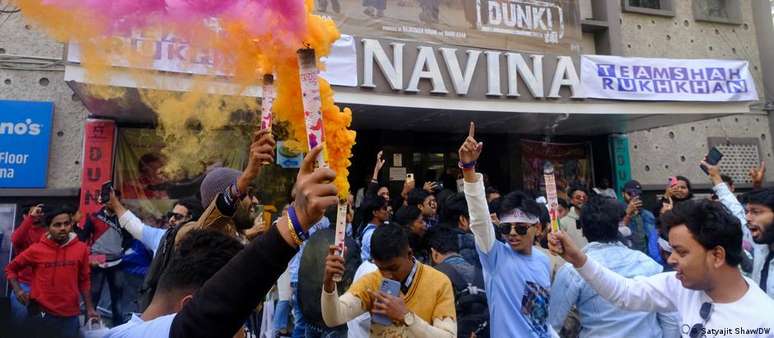Indian film stars have legions of fans in Pakistan despite political rivalry between neighboring nations. The reasons for this popularity Relations between Pakistan and India have rarely been cordial, mainly due to the dispute over the territory of Kashmir. But that doesn’t stop many Pakistani viewers from being ardent followers of Bollywood and its stars.
Films in Pakistan must be cleared by regional committees that censor any work deemed to violate the country’s social and cultural values. And as of 2019, films produced by India’s Hindi film industry, based in the country’s financial capital Mumbai and more popularly known as Bollywood, are not allowed in Pakistani cinemas.
When the box office hit Pathaan, starring actor Shah Rukh Khan, was clandestinely screened in Karachi’s opulent DHA neighborhood in January 2023, the censor board of Pakistan’s southern Sindh province, where the city is located, blocked the screening of the film.
Actors and the Hindi language: strong attractions
Apart from Shah Rukh Khan, known as the king of Bollywood, whose latest comedy-drama Dunki hit theaters earlier this month, other Bollywood actors like Aamir Khan, Deepika Padukone and Ranbir Kapoor have many admirers in Pakistan.
In recent years, films produced in the southern part of India, or directed by directors from the south, have gained popularity in Pakistan due to their action- and technology-oriented plots.
Apart from the allure of Bollywood, another attraction is the Hindi language used in films. Hindi is similar to Urdu, a language widely spoken in Muslim-majority Pakistan. Furthermore, some of the artists and technicians working in Bollywood are of Muslim origin.
Bollywood: marketing or entertainment?
Despite the tensions between India and Pakistan, similar cultural aspects persist between the two nations, particularly when it comes to films and music.
“I heard a TV presenter talk about it the other day. He thought that before 1947 in undivided India we made similar films,” Pakistani actor Mohib Mirza told DW.
“Our heroes also sang songs in the valleys and around the trees. But I think influence is another matter. Bollywood is not original, it is heavily influenced by many other countries,” Mirza said.
“The reason why our audiences watch Indian films is the way they market their material,” Mirza added. “Whatever happens, we will get the news about what is happening in India.”
Journalist Ghazi Salahuddin disagrees with Mirza’s opinion. “Bollywood has a lot of influence in Pakistan, especially because her films are widely seen in the country for their quality and entertainment content, something we lack,” says Salahuddin.
“They have also adapted to technological advances,” he said. “They have a large international market and therefore can afford to experiment and spend a lot of money on their film productions. India’s economic success also plays an important role in this.”
Indian and Pakistani films have song and dance sequences in common, according to director Shoaib Sultan, whose directorial debut, Gunjal, opened in theaters on December 15. “It’s a huge industry. Our audience watches it because it’s entertaining and goes beyond everyday life.”
Lack of Pakistani films
Because Pakistan does not have a large film sector of its own, the country’s film distributors and theater owners are largely dependent on releases from major Hollywood studios to keep their businesses afloat.
“As long as we don’t make films in Pakistan, people will continue to watch Bollywood,” said film distributor and exhibitor Nadeem Mandviwalla.
“These are the only two countries in the world that make films the same way: song and dance sequences, dress and language, etc.,” he said. “They call it Hindi language and we call it Urdu.”
“Peace activists on both sides continue to try to lower the temperature in the political field,” Salahuddin said. “Indians and Pakistanis travel a lot and have large diasporas, so they meet in other parts of the world.”
Mandviwalla highlights the importance of Indian films in Pakistan. “Our people know a lot about India through exposure to Indian films,” the distributor said. “For the last 40 years, Pakistani audiences have been watching Bollywood content.”
But since Pakistan banned Indian films in 2019, exhibitors and distributors in the country have been struggling.
“We exhibitors have conveyed to the government that there are only two options: allow Indian content or make at least 100-150 films a year, which will help Pakistan’s film sector stay on its feet,” Mandviwalla said.
As government leaders work to resolve political differences between neighboring countries, their people can continue to focus on their cultural similarities.
Source: Terra
Rose James is a Gossipify movie and series reviewer known for her in-depth analysis and unique perspective on the latest releases. With a background in film studies, she provides engaging and informative reviews, and keeps readers up to date with industry trends and emerging talents.



![Tomorrow belongs to us: What awaits you in the episodes of 2052 and 2053 on October 15, 2025 [SPOILERS] Tomorrow belongs to us: What awaits you in the episodes of 2052 and 2053 on October 15, 2025 [SPOILERS]](https://fr.web.img6.acsta.net/img/39/95/3995a2d00abbf3c01161818d01a95388.jpg)


